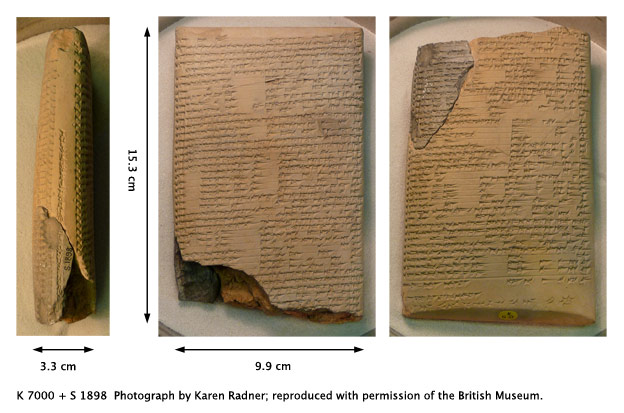K 7000 + Sm 1898: manuscript of the liver omen series, from Assurbanipal's library at Nineveh

K 7000 + Sm 1898: manuscript of the liver omen series bārûtu (sub-series pān tākalti, tablet IV), from Assurbanipal's library at Nineveh (Neo-Assyrian period, c.650 BC). Photograph by Karen Radner; reproduced with permission of the British Museum. View large image.
The canonical version of the Babylonian omen series bārûtu (i.e., divination from the liver and other entrails of sheep) consists of ten sub-series. The one called pān tākalti is concerned with omens derived from certain physical features found on the front of the liver. This manuscript is the fourth tablet of the sub-series which mostly deals with a part of the liver called the Strength TT (danānu). You will notice that most of the lines start with the same two signs: 𒁁 𒆗 BE KAL, standing for šumma danānu 'If the Strength'.
This copy of the fourth tablet of pān tākalti was made for the Assyrian royal library during the reign of Assurbanipal, as is mentioned in the so-called colophon of the tablet. This is the last section of text on a library tablet, usually found at the very bottom of its reverse side, which mentions the details of the specific manuscript's creation. Have a look for Assurbanipal's name and titles in the last line: 𒁹 𒀭 𒄭 𒆕 𒀀 𒌋𒌋 𒋙 𒌋𒌋 𒆳 𒀭 𒄭 𒆠 mAN.ŠAR2-DU3-A MAN ŠU2 MAN KUR AN.ŠAR2ki, which stands for šar kiššati šar māt Aššur, 'king of the universe, king of Assyria'. (Make sure the cuneiform font is switched to NA.)
Tablets created for Assurbanipal's library were prepared with great care. The tablets' core was covered with a layer of especially fine clay that enabled the scribes to write in extremely small signs with a height of just 2-3 mm. You can see this clay layer in the photo of the obverse: note the pink coating visible in the cross-section created by the break. The fine outer layer and the tiny script as well as certain sets of standard tablet measurements are all typical for tablets from Assurbanipal's library.
On the reverse, you can see that a fragment of a different colour has been re-attached to the main tablet. This is what Assyriologists call a 'join', i.e. the merging of fragments of the same original manuscript. It is reflected by our tablet's museum inventory number: K 7000 + Sm 1898 designates the two fragments. The first and bigger was excavated by Hormuzd Rassam in the early 1850s (K stands for Kuyunjik, the modern name of the citadel mound of Nineveh PGP ). The second was found some twenty years later by George Smith (Sm being an abbreviation of his name), who examined the waste dumps of Rassam's excavations for overlooked fragments. Our tablet was broken when the Babylonian and Median armies conquered Nineveh in 612 BC and looted the royal palace. The fact that the two fragments, now separated, were exposed to the ensuing fire and then to slightly different soil conditions during the long centuries before they were excavated in the mid-19th century is responsible for the very different colouring of their surfaces. The lower part of the manuscript is still missing. It may have been smashed into tiny splinters, which the early excavators would not necessarily have deemed worthy of transport back to London, or into larger fragments, which may one day be identified in the British Museum.
A transliteration and translation of this tablet can be found in Koch-Westenholz, Babylonian liver omens (2000), pp. 316-325 no. 59 (manuscript A).
Content last modified on 05 Dec 2016.
Karen Radner
Karen Radner, 'K 7000 + Sm 1898: manuscript of the liver omen series, from Assurbanipal's library at Nineveh', Knowledge and Power, Higher Education Academy, 2016 [http://oracc.museum.upenn.edu/saao/knpp/cuneiformrevealed/tabletgallery/k7000sm1898/]